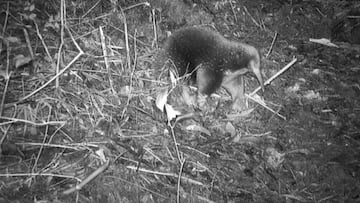Explorers reclaim 60-year-old mystery: meet the Zaglossus of Sir David
Just as the expedition was about to finish, one of the cameras hidden in the jungle captured the animal that had not been seen since 1961.

In a thrilling breakthrough, a long-lost mammal species has been rediscovered in Indonesia’s Cyclopean Mountains. The Zaglossus of Sir David, also known as Attenborough’s Long-Beaked Echidna, combines the spiky defenses of a hedgehog, the elongated snout of an anteater, and the burrowing legs of a mole. First sighted over six decades ago, this elusive creature was recently photographed in Papua, eastern Indonesia, reigniting hopes for its survival.
The remarkable discovery was made using a camera trap on the final day of a four-week expedition led by scientists from Oxford University. Biologist James Kempton stumbled upon images of the tiny animal navigating through dense forest underbrush on the last memory card retrieved from more than 80 cameras scattered throughout the wilderness.
إيكيدنا السير ديفيد طويل المنقار -
— حيوانات ومعلومات (@animalfaar) December 4, 2024
Sir David's long-beaked echidna
الاسم العلمي: Zaglossus attenboroughi
يُعرف أيضًا باسم إيكيدنا أتينبورو طويل المنقار أو إيكيدنا ذو المنقار الطويل العملاق ، يتدحرج إلى كرة شوكية عندما يشعر بالتهديد. سميت تكريما للسير ديفيد أتينبورو.
تعيش في جبال… pic.twitter.com/HEmmuXNWK1
Echidna’s narrow escape from extinction
Kempton shared with the BBC that finding evidence of the Zaglossus of Sir David was a race against time. The dedicated team of 25 was on the brink of leaving empty-handed until they uncovered the vital footage just in the nick of time. This rediscovery underscores the importance of perseverance in wildlife research.
Belonging to the echidna family, which includes only four known species—three of which are Zaglossus—these mammals have ancient origins dating back approximately 200 million years to the Triassic and Jurassic periods. Their closest relatives are the platypuses, with whom they share unique traits like egg-laying and a cloaca, a single exit point for their digestive, urinary, and reproductive systems.
The 2023 expedition, a collaborative effort between Oxford researchers, local groups, and NGOs, explored over 200 square kilometers of the Cyclopean Mountains' rainforest at elevations around 2,000 meters. Besides the Zaglossus, the team discovered several new insect species, two frog varieties, and a crustacean, highlighting the region’s rich biodiversity.
Critical conservation status
Currently listed as critically endangered by the International Union for Conservation of Nature (IUCN) Red List, the Zaglossus of Sir David’s rediscovery doesn’t immediately change its perilous status. However, the find aims to raise awareness about the urgent need to protect this species and others facing similar threats.
Additionally, the Zaglossus holds significant cultural importance locally, where it’s featured in traditional practices for conflict resolution, further emphasizing the necessity of its preservation.
Related stories
Get your game on! Whether you’re into NFL touchdowns, NBA buzzer-beaters, world-class soccer goals, or MLB home runs, our app has it all.
Dive into live coverage, expert insights, breaking news, exclusive videos, and more – plus, stay updated on the latest in current affairs and entertainment. Download now for all-access coverage, right at your fingertips – anytime, anywhere.
Complete your personal details to comment